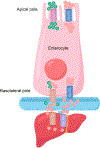"Sweet death": Fructose as a metabolic toxin that targets the gut-liver axis
- PMID: 34619076
- PMCID: PMC8665123
- DOI: 10.1016/j.cmet.2021.09.004
"Sweet death": Fructose as a metabolic toxin that targets the gut-liver axis
Abstract
Glucose and fructose are closely related simple sugars, but fructose has been associated more closely with metabolic disease. Until the 1960s, the major dietary source of fructose was fruit, but subsequently, high-fructose corn syrup (HFCS) became a dominant component of the Western diet. The exponential increase in HFCS consumption correlates with the increased incidence of obesity and type 2 diabetes mellitus, but the mechanistic link between these metabolic diseases and fructose remains tenuous. Although dietary fructose was thought to be metabolized exclusively in the liver, evidence has emerged that it is also metabolized in the small intestine and leads to intestinal epithelial barrier deterioration. Along with the clinical manifestations of hereditary fructose intolerance, these findings suggest that, along with the direct effect of fructose on liver metabolism, the gut-liver axis plays a key role in fructose metabolism and pathology. Here, we summarize recent studies on fructose biology and pathology and discuss new opportunities for prevention and treatment of diseases associated with high-fructose consumption.
Keywords: NASH; cancer; fructos; gut inflammation; metabolic disease.
Published by Elsevier Inc.
Conflict of interest statement
Declaration of interests M.K. holds US Patent No. 10034462 B2 on the use of MUP-uPA mice for the study of NASH and NASH-driven HCC. M.A.F. is a co-inventor of IC7Fc and hold patents for this molecule (US 60/920,822; WO/2008/119110 A1).
Figures



References
-
- Abdel-Sayed A, Binnert C, Lê KA, Bortolotti M, Schneiter P, and Tappy L (2008). A high-fructose diet impairs basal and stress-mediated lipid metabolism in healthy male subjects. Br. J. Nutr 100, 393–399. - PubMed
-
- Adelman RC, Ballard FJ, and Weinhouse S (1967). Purification and properties of rat liver fructokinase. J. Biol. Chem 242, 3360–3365. - PubMed
-
- Ahmad U, and Sharma J (2021). Fructose 1-phosphate aldolase deficiency. In StatPearls (StatPearls Publishing; ). - PubMed
-
- Aldámiz-Echevarría L, de Las Heras J, Couce ML, Alcalde C, Vitoria I, Bueno M, Blasco-Alonso J, Concepción García M, Ruiz M, Suárez R, et al. (2020). Non-alcoholic fatty liver in hereditary fructose intolerance. Clin. Nutr 39, 455–459. - PubMed
Publication types
MeSH terms
Substances
Grants and funding
LinkOut - more resources
Full Text Sources
Medical

